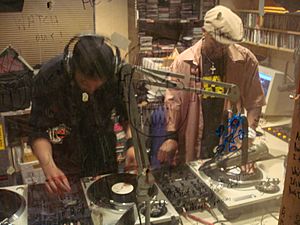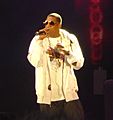Hip hop (culture) facts for kids
Hip hop is a vibrant culture and art form that started in the the Bronx, New York City. It was created by African Americans and later grew to include Latino Americans and Caribbean Americans. Hip hop culture is known for four main parts: rapping, DJing (mixing music), breakdancing, and graffiti art.
Other important parts of hip hop include knowing its history, beatboxing (making sounds with your mouth), street entrepreneurship (starting small businesses), its own language, and hip hop fashion. Some people even call these the "fifth element."
The hip hop scene began in August 1973 when DJ Kool Herc and his sister Cindy Campbell held the first hip hop party in the Bronx. This event helped start the whole genre. Hip hop has since spread to cities and towns all over the United States and then around the world. As it grew, these art forms changed and mixed with local styles, especially in the 1990s and beyond. Even as hip hop keeps growing globally, these four main elements keep the culture strong and connected.
Hip hop is both new and old at the same time. A big part of it is sampling (taking) sounds, beats, and basslines from old songs. This means much of the culture is about updating classic recordings and ideas for today's audiences. Taking older culture and using it in a new way is called "flipping" in hip hop. Hip hop music follows in the footsteps of other African-American and Latino music styles like blues, jazz, rag-time, funk, salsa, and disco. It is now one of the most popular music styles worldwide.
Contents
How Hip Hop Got Its Name
Keith "Cowboy" Wiggins, a member of the group Grandmaster Flash and the Furious Five, is often given credit for coming up with the term "hip hop" in 1978. He was teasing a friend who had joined the US Army by singing "hip/hop/hip/hop" like marching soldiers. Soon, this name stuck for the new music and culture.
The famous song "Rapper's Delight" by The Sugarhill Gang, released in 1979, starts with the line "I said a hip, hop, the hippie the hippie to the hip hip hop, and you don't stop." The 1980 hit "Rapture" by Blondie also has a rap part that says, "And you hip-hop, and you don't stop..." Lovebug Starski and DJ Hollywood, who were DJs from the Bronx, then started using the term when talking about this new "disco rap" music.
Afrika Bambaataa, a pioneer of hip hop and a community leader, also says that Lovebug Starski was the first to use "hip hop" for the culture. Bambaataa helped make the term even more popular. The first time "hip hop" was written down, specifically talking about the culture, was in a January 1982 interview with Afrika Bambaataa by Michael Holman. The term became even more common later that year in an article about Bambaataa in The Village Voice.
Hip Hop's Impact on Society
How Hip Hop Spreads
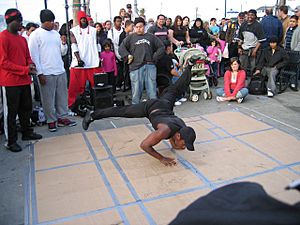
Hip hop has had a huge impact on society since it started in the 1970s. It is even important in education because it helps us understand language, learning, and identity. Orlando Patterson, a professor at Harvard University, explains how hip hop has spread quickly around the world. He says that in many countries, rich people, governments, and big businesses control how information is shared.
He believes this mass communication has helped create a global hip hop scene. As a result, young people everywhere are influenced by American hip hop and start their own versions. Patterson thinks that hip hop music will keep growing around the world as traditional values mix with American hip hop. This will create a global exchange where young people worldwide listen to a common type of hip hop music.
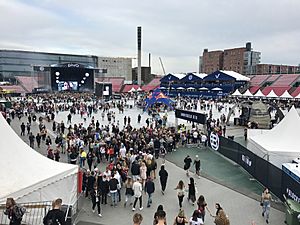
Some people also say that rap music began as a way to respond to unfair treatment and racism. It became a way for Black communities across the United States to communicate. This is because hip hop culture showed the social, economic, and political challenges faced by young people who felt left out. In the 2010s, hip hop lyrics started to go back to their original themes of social awareness. Rappers began to question the power of governments and their unfair roles in some societies. Rap music has been a tool for political, social, and cultural empowerment outside the United States. For example, people from minority groups, like Algerians in France and Turks in Germany, use rap to speak out against racism, poverty, and social problems.
Hip Hop Fashion

Clothes, hairstyles, and other styles have been a big part of hip hop's social and cultural impact since the 1970s. Even though styles have changed over the years, unique urban clothing and looks have been an important way for rappers, breakdancers, and other hip hop community members to express themselves. As hip hop music became more popular, its fashion also became more influential.
Different Kinds of Hip Hop
Hip hop music has created many different subgenres. These new styles use hip hop music techniques like sampling sounds, making beats, or rapping. This variety comes from other groups adopting hip hop culture. Many different social influences affect the message of hip hop in different countries. It is often used as a musical way to respond to unfair political or social situations.
In South Africa, the biggest form of hip hop is called Kwaito. It has grown in a similar way to U.S. hip hop. Kwaito directly reflects a post-apartheid South Africa (after the end of racial segregation) and gives a voice to those who felt unheard. Kwaito is even seen as a lifestyle, including many parts of life like language and fashion.
Kwaito is a political and party-focused music style. Performers use the music to share their political views and to express their desire to have fun. Kwaito came from a people who were once disliked and treated unfairly, but it is now popular across the nation. Most Kwaito listeners are teenagers, and half of South Africa's population is under 21. Some big Kwaito artists have sold over 100,000 albums. In an industry where selling 25,000 albums is considered a "gold record," these are very impressive numbers. Kwaito allows people who were once left out of society to take part and be creative in popular media. South African hip hop has made an impact worldwide, with artists like Tumi, HipHop Pantsula, and Tuks Senganga.
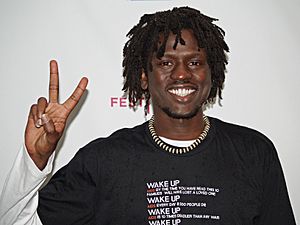
In Jamaica, hip hop sounds come from both American and Jamaican influences. Jamaican hip hop is shaped by dancehall and reggae music. Jamaican Kool Herc brought the sound systems, technology, and techniques of reggae music to New York in the 1970s. Jamaican hip hop artists often rap using both Brooklyn and Jamaican accents.
In developing countries, hip hop has had a big social impact. Even with limited resources, hip hop has made great progress. Because money is scarce, hip hop artists have to use very basic tools. Even graffiti, an important part of hip hop culture, is limited because spray paint might not be available to everyone. Hip hop has also started to include more than just Black artists. Many first-generation minority children are growing up and becoming central figures. For example, rapper Awkwafina, who is Asian-American, raps about being Asian and female. Like many others, she uses rap to share her experiences as a minority, not necessarily to "unite" minorities, but to tell her own story.
Many hip hop artists from developing countries come to the United States to find opportunities. Maya Arulpragasm (also known as M.I.A.), a Tamil hip hop artist born in Sri Lanka, says, "I'm just trying to build some sort of bridge, I'm trying to create a third place, somewhere in between the developed world and the developing world." Another musician using hip hop to share a positive message with young Africans is Emmanuel Jal. He was a child soldier from South Sudan. Jal is one of the few South Sudanese musicians to become famous internationally with his unique hip hop style and positive lyrics. Jal has gained attention from media and experts for his story and how he uses hip hop to help people affected by war in Africa. He has also been invited to speak at international events like TED.
Many K-Pop artists in South Korea have been influenced by hip hop, and many South Korean artists perform hip hop music. In Seoul, South Korea, Koreans also enjoy b-boying (breakdancing).
Hip Hop and Education
Experts say that hip hop can make young people feel more powerful. While some rap music videos and lyrics might show violence, hip hop also has many positive messages about being self-reliant, strong, and having good self-esteem. These messages can inspire young people living in poverty. Many rap songs talk about making the African American community stronger and supporting social causes. Social workers have used hip hop to build relationships with young people who are at risk and to connect with them more deeply.
Hip hop can be taught as a way to help people think more critically about the world. This can be through writing, making music, or social activism. The lyrics of hip hop have been used to learn about literary tools like metaphor, imagery, irony, tone, theme, plot, and point of view.
Organizations and places are creating spaces and programs for communities to learn about and make hip hop. One example is the IMP Labs in Regina, Saskatchewan, Canada. Many dance studios and colleges now offer hip hop lessons alongside tap and ballet. Also, KRS-One teaches hip hop lectures at Harvard University. Hip hop producer 9th Wonder and former rapper-actor Christopher "Play" Martin from the group Kid-n-Play have taught hip hop history classes at North Carolina Central University. 9th Wonder has also taught a "Hip Hop Sampling Soul" class at Duke University. In 2007, the Cornell University Library started a Hip Hop Collection to gather and make available historical items from hip hop culture. This helps make sure they are saved for future generations.
The hip hop community has also played a big part in teaching its listeners about HIV/AIDS, a disease that has greatly affected the community.
See also
 In Spanish: Hip hop para niños
In Spanish: Hip hop para niños
- List of hip hop genres
- Pop culture
Images for kids
-
DJ Jazzy Jeff, who is also a record producer, manipulating a record turntable in 2005.
-
Afrika Bambaataa with DJ Yutaka of Universal Zulu Nation in 2004
-
The Beastie Boys in 2004
-
Grandmaster Melle Mel
-
British hip hop artist and poet Kae Tempest performs her signature piece "Let Them Eat Chaos" at the 2017 Treefort Music Fest in Boise, Idaho.
-
Rapper, entrepreneur and executive Jay-Z emphasizes his wealth.
-
DJ Qbert manipulating a record turntable at a turntablism competition in France in 2006
-
DJ Pete Rock mixing with two turntables
-
Rapper Busta Rhymes performs in Las Vegas for a BET party
-
An aerosol paint can, a common tool used in modern graffiti
-
PHASE 2 is an influential graffiti artist who began painting in the 1970s.
-
Biz Markie is noted for his beatboxing skills. He is holding the mic close to his mouth, a technique beatboxers use to imitate deep basslines and bass drums, by exploiting the proximity effect.
-
While hip hop music makes a significant use of sampling old records, using turntables and drum machines to create beats, producers use electric and acoustic instruments on some songs. Pictured is an electric bass player at a hip hop show.
-
A b-boy performing in San Francisco
-
A graffiti artist uses his artwork to make a satirical social statement on censorship: "Don't blame yourself ... blame hip hop!"
-
Potato chip packages featuring hip hop-design images (showing Lil Romeo and based on the film Honey)
-
Rapper Dr. Dre has endorsed a line of headphones and other audio gear called "beats", which bear his name.
-
Graffiti depicting US rapper 50 Cent.
-
Hip hop artist Lauryn Hill has been successful as a solo performer and as a member of the Fugees. This photo shows her performing at the Ottawa Bluesfest in 2012.
-
Mary J. Blige performing


